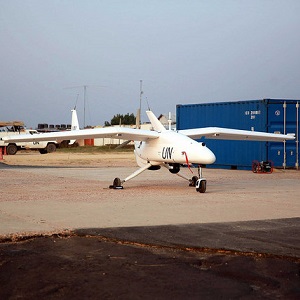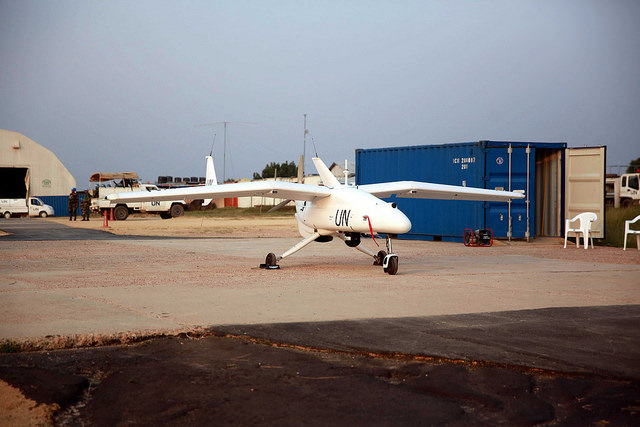Eye in the Sky
September 2017
In 2007, for the first time in history, UN forces operated an unmanned aerial vehicle – a small prototype for a short period in the UN Mission in Haiti. In 2013, the UN formally launched drones (formally known as unmanned aerial systems – UAS) for surveillance in a peacekeeping mission. Despite the controversies around their use, especially due to the uncertainty of how the data gathered is secured and used, drones became important to securing day and night real-time imagery to the Blue Helmets deployed in the Democratic Republic of Congo (DRC). The objective was to monitor some of the illegal armed groups in the Eastern region of DRC, along with protecting the civilian population more efficiently.
During a research trip to Goma in 2015, I had the opportunity to witness the use of drones by MONUSCO. The mission’s UAS Chief told me that, as long as the five drones operating in the country provided situational awareness, they were considered to be an asset for the whole UN system, both in the field and in NYC. Adopting a similar line of thinking, the Final Report of the Expert Panel on Technology and Innovation in UN Peacekeeping endorsed the drones use with full transparency, highlighting that they can bring decided advantages to a peacekeeping operation in the areas of safety, security, situational awareness, and command and control.
In great part due to the controversies around the ethics and effects of using this type of technology, UN missions have been only operating unarmed UAS and so it will remain. Purposely, a start contrast with the fuzzy boundary between the use of armed and unarmed drones used by the United States military, especially within the context of the “war on terror.” Moreover, the UN has often adopted a cautious stance on the further development of drones and related technologies. For instance, in 2013, a UN Human Rights Council Report called for a moratorium on the development and use of lethal autonomous robots.
While the use of armed drones for military purposes became popular in the 1990s, the use of unarmed ones for non-military tasks is still emerging as an innovative tool for preventing conflicts. They have proven particularly useful in monitoring and surveillance, providing information for the protection of civilians (PoC) and the prevention of conflicts breakouts. They can also be used for remote sensing, to extend wi-fi connectivity, or to bypass areas with poor or non-existing infrastructure. Perhaps their main advantage in conflict-affected countries is the cost-effective provision of imagery from remote locations that otherwise would be extremely difficult to access.
One of the most promising examples of drone use in conflict settings today involves real-time monitoring in Mali. The landlocked territory in the Sahel has a plethora of different landscapes, from the Sahara in the North and the mountains in the Northeast to the savannah in the South. This challenging and diverse terrain presents difficulties for humanitarian and development missions in the already turbulent country, which has been rocked by separatism and actions by extremist groups. The United Nations Development Program (UNDP) is using drones – combined with satellite imagery – to enable real-time monitoring in order to support activities of humanitarian and development actors in the field, particularly those working on community development for emergency services. The project is mapping UNDP’s presence in Timbuktu and providing information about geography, adverse natural and anthropogenic hazards, besides updating on project activities in the region.
Despite these capabilities, the feasibility of using drones more widely for conflict prevention initiatives remains to be seen. For instance, in 2014, the United Nations Office for the Coordination of Humanitarian Affairs (OCHA) released a policy brief advising against their use. OCHA’s main concerns focus on the association of unarmed drones with armed ones, causing fear, as well as surveillance, raising issues of privacy. These caveats underscore the need to disseminate awareness of the advantages of unarmed drones in preventing armed conflicts, along with the differences in design and purpose regarding armed ones.
Nonetheless, surveillance with drones in peace operations remains a thorny issue, considering that it raises a wide gamut of legal and ethical questions. While addressing these queries and concerns is necessary to ensure that such technologies are used in ethical, effective, and legitimate ways, there is clearly a need to ponder how their use changes across different contexts. For instance, what are the differences and similarities between the use of high-technological surveillance system in London and the use of government-authorized surveillance drones in Timbuktu? How do these different contexts shape the legal and ethical dimensions of using drones to prevent violence, whether urban crime or armed conflict?
Rather than shelving the technology altogether, international organizations should lead the debates on the use of drones for conflict prevention, whether in the context of monitoring of a range of actions, from development projects in remote locations, shipments of illegal armaments, forced migrations, to the threat of violence and genocide. Think contrafactually on past genocides: would the events have unfolded in the same way had droned been available and deployed then? Alternatively, on current trouble spots: would protection of civilians in the Central African Republic or Somalia be enhanced through the use of drones? Collaboration with civil society entities, as well as the private sector – for instance, the drones in DRC were produced and are operated by an Italian company, will be essential in promoting regulation of drone and related emerging technologies.
In conflict-affected countries, there is no reason to crowd the skies with drones–but there is clearly a need to keep an eye in the sky when and where it is possible or even necessary to resort to drones. While no technology saves lives by itself—its impact ultimately depends on what decisionmakers do with the information provided—there is a growing need to explore the potential of new technologies for preventing violence in conflict-affected countries.
Giovanna Kuele




